
The Province of Lecco is a province in the Lombardy region of Italy. Its capital is the city of Lecco.

Cospaia is an Italian hamlet (frazione) of the comune of San Giustino in the Province of Perugia, Umbria.
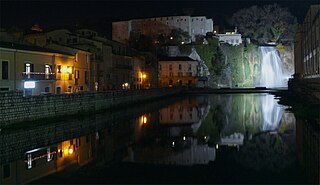
Isola del Liri is an Italian town of Lazio, Italy, in the province of Frosinone. As its name implies, Isola is situated between two arms of the Liri. The many waterfalls of this river and of the Fibreno are used by factories.

Maddaloni is a town and comune of Campania, Italy, in the province of Caserta, about 5 kilometres (3 mi) southeast of Caserta, with stations on the railways from Caserta to Benevento and from Caserta to Naples.
The music of Milan has ancient roots. The Ambrosian chants are among the first codified music in Western culture, which fact led to the later development of its concept of scales, for example. In more recent history, the city of Milan has been an important social, cultural, political and commercial center not just in Italy, but in all of Europe.
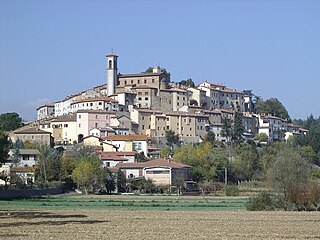
Monterchi is a Comune (Municipality) in the Province of Arezzo in the Italian region of Tuscany, located about 80 kilometres (50 mi) southeast of Florence and about 20 kilometres (12 mi) east of Arezzo. It sits in the northern part of Valtiberina, the valley where the Tiber river runs going from Emilia-Romagna towards Rome. The valley runs through Romagna, Tuscany and Umbria, parallel to the Casentino Valley.

Fratta Todina is a comune in the Province of Perugia in the Italian region Umbria, located about 30 km south of Perugia.

Monte Castello di Vibio is a comune (municipality) in the Province of Perugia in the Italian region Umbria, located about 30 km south of Perugia. Monte Castello di Vibio borders the following municipalities: Fratta Todina, San Venanzo, Todi.

The Sacred Mountain of Varallo is a Sacro Monte overlooking the town of Varallo Sesia in the province of Vercelli, Piedmont, northern Italy. It is the oldest Sacro Monte, founded in 1491 by Franciscan friar Bernardino Caimi. It is built on a natural terrace on the rocky slopes of Monte Tre Croci, on the left bank of the Sesia river where it leaves Val Mastallone. It is 600 m above sea level, 150 m above the historic centre of Varallo.

Arnoldo Foà was an Italian actor, voice actor, theatre director, singer and writer. He appeared in more than 130 films between 1938 and 2014.
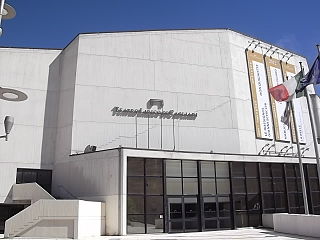
The Teatro Lirico di Cagliari is an opera house in Cagliari. It is the main theatre of the city.
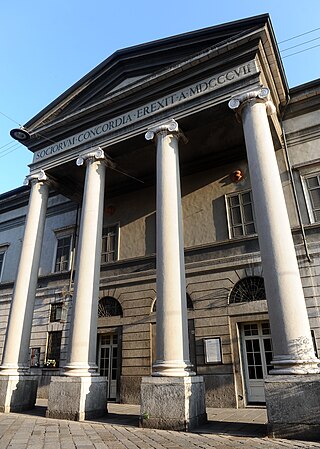
The Teatro Comunale Ponchielli, as it has been known since 1986, is an opera house located in Cremona, Italy. For more than 250 years it has been that city's primary venue for opera and other theatrical presentations.

Johanna Beisteiner is an Austrian classical guitarist, singer and arranger.

Teatro San Ferdinando is a theatre in Naples, Italy. It is named after King Ferdinand I of Naples. Located near Ponte Nuovo, it is to the southeast of the Teatro Totò in the western part of the neighborhood of Arenaccia. Built in the late eighteenth century, the seats are arranged in four box tiers, and the pit. It is most associated with Eduardo De Filippo and the productions of the 1950s under his direction. Closed in the 1980s and reopened in 2007, the San Fernando is managed by the Teatro Stabile of Naples.

Romeo Castellucci is an Italian theatre director, playwright, artist and designer. Since the 1980s he has been one part of the European theatrical avant-garde.

The Castello Bufalini is a castle-residence outside of the town of San Giustino, Province of Perugia, in the Region of Umbria, Italy.

Paolo Lioy was an Italian naturalist, redshirt patriot and politician.

The Stinche Prison was a prison on Via Ghibellina in the city of Florence, Italy. It stood more or less on the site now occupied by the Teatro Verdi.
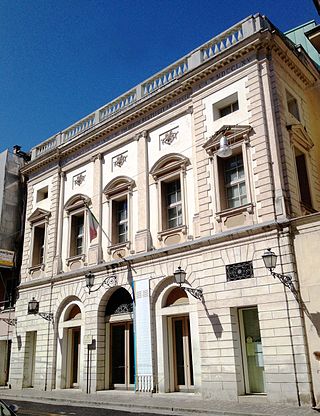
The Teatro Mario Del Monaco is an opera house and theatre in Treviso, Italy. It was previously known as the Teatro Onigo from 1692 to 1846, the Teatro Sociale from 1847 to 1930, and the Teatro Comunale from 1931 to 2011. In 2011, it was renamed in honour of the Italian tenor Mario Del Monaco who lived in Treviso from 1975 until his death in 1982. It is located in the historic centre of the city on the Corso del Popolo and since 2019 has been run by the Teatro Stabile del Veneto which also runs the Teatro Goldoni in Venice and the Teatro Verdi in Padua.

Teatro Coccia is the main opera house in Novara, and is also the most important "historical" theatres in Piedmont. It faces along via Fratelli Rosselli, and delimits piazza dei Martiri to the west and piazza Giacomo Puccini to the east.




























